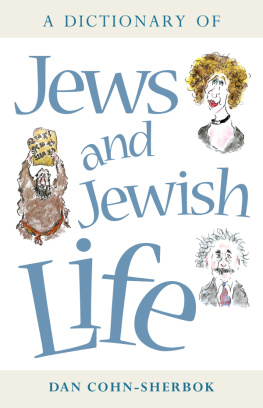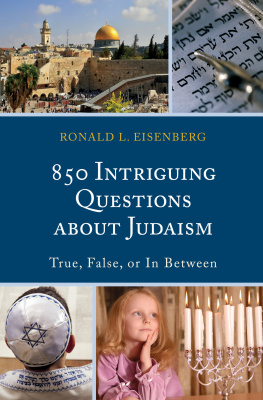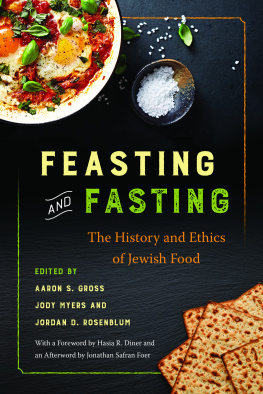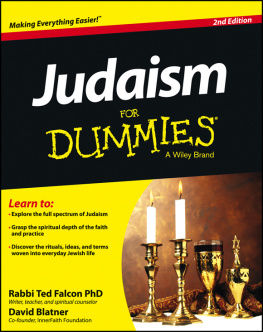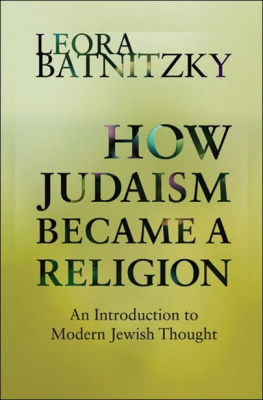PENGUIN BOOKS
THE JEWISH PEOPLE
Rabbi Dr David J. Goldberg is Senior Rabbi of the Liberal Jewish Synagogue in London. He was educated at Manchester Grammar School, Oxford University and Trinity College, Dublin, and received his Rabbinic Ordination from the Leo Baeck College, London, in 1971.
A regular contributor on Jewish and Israeli topics to The Times, the Guardian, the Observer, the Independent and other major newspapers and journals, in 1999 Rabbi Goldberg was awarded the Gold Medallion of the International Council of Christians and Jews for his Interfaith work. He is the author of To the Promised Land, also published by Penguin, which was awarded the Premio Iglesias for its Italian version in 2000.
Rabbi John D. Rayner was born in Germany in 1924 and arrived in England days before the start of the Second World War. After four years service in the British Army, he spent six years at Cambridge, reading modern languages, moral science and oriental languages. Subsequently he received his Rabbinic Ordination in the United States. In Britain he served the South London Liberal Synagogue and then the Liberal Jewish Synagogue in St Johns Wood, becoming Senior Minister in 1961 and Emeritus Minister in 1989. Since 1966 he has, in addition, taught liturgy and rabbinic literature at Leo Baeck College. He has co-edited (with Rabbi Chaim Stern) three pioneering Progressive Jewish Prayer Books, Service of the Heart, Gate of Repentance and Siddur Lev Chadash. He has also written (with Rabbi Bernard Hooker) Judaism for Today, a restatement of the position of British Liberal Judaism. In addition, he has published two volumes of sermons, An Understanding of Judaism and A Jewish Understanding of the World, and a collection of essays, Jewish Religious Law: A Progressive Perspective. He received the CBE in 1995.
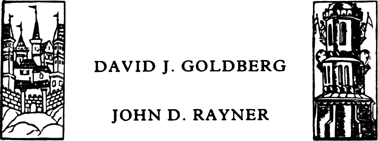
THE JEWISH PEOPLE
THEIR HISTORY
AND THEIR RELIGION

PENGUIN BOOKS
PENGUIN BOOKS
Published by the Penguin Group
Penguin Books Ltd, 80 Strand, London WC2R 0RL , England
Penguin Putnam Inc., 375 Hudson Street, New York, New York 10014, USA
Penguin Books Australia Ltd, Ringwood, Victoria, Australia
Penguin Books Canada Ltd, 10 Alcorn Avenue, Toronto, Ontario, Canada M4V 3B2
Penguin Books India (P) Ltd, 11 Community Centre, Panchsheel Park, New Delhi 110017, India
Penguin Books (NZ) Ltd, Cnr Rosedale and Airborne Roads, Albany, Auckland, New Zealand
Penguin Books (South Africa) (Pty) Ltd, 24 Sturdee Avenue, Rosebank 2196 South Africa
Penguin Books Ltd, Registered Offices: 80 Strand, London WC2R 0RL , England
www.penguin.com
First published by Viking 1987
Published in Penguin Books 1989
14
Copyright David J. Goldberg and John D. Rayner, 1987
All rights reserved
Except in the United States of America, this book is sold subject to the condition that it shall not, by way of trade or otherwise, be lent, re-sold, hired out, or otherwise circulated without the publishers prior consent in any form of binding or cover other than that in which it is published and without a similar condition including this condition being imposed on the subsequent purchaser
978-0-14-194124-0
CONTENTS
ILLUSTRATIONS
The woodcut illustrations on the title and half-title pages are reproduced from Die Prager Hagada von 1526, published by the Verlag fr Jdischer Kunst und Kultur Fritz Gurlitt, Berlin 1920. The Hebrew alphabet reproduced on the chapter openings was used in Christopher Plantins Biblia sacra of 1569. Photos courtesy of Berthold Wolpe.
PREFACE
It is with great diffidence that one presumes to add yet another book to the enormous stockpile of literature which over the centuries has accreted around the people of the Book. That Jews should be interested in themselves is understandable; but their experience in history has aroused almost as much interest and comment from outside observers. Their stubborn fidelity to the faith of their ancestors, their resilience in adversity and their knack of adapting their talents and energies to changed circumstances, have ensured their survival long after the Greek civilization, which treated them with condescension, and the Roman empire, which held them in contempt, have passed into oblivion.
The two great religions of Christianity and, to a lesser extent, Islam owe their being to Judaism. The complexities of coping with a rejected mother religion whose adherents refused to convert or disappear encouraged medieval Christianity to excesses of anti-Jewish persecution which led, ultimately and inexorably, to the horrors of Hitlers Holocaust; and even Islam, with a theology more respectful towards Abraham and his monotheistic descendants, has on occasion been guilty of savage hostility towards its Jewish subjects.
Small wonder, then, that this numerically insignificant people and their religion located, by chance or providence, at the geographical and cultural crossroads of early western civilization should have exerted such a perennial fascination. During the Age of Enlightenment the notion took root among those sympathetic to Judaism that the manner in which the state treated its Jewish minority was a barometer of its civilization. The appalling evidence of the concentration camps prompted a surge of guilty sympathy from western countries towards the survivors of Belsen and Auschwitz, but since the establishment of the State of Israel a state which has revived biblical language and place-names but behaves, on occasion, like any other modern practitioner of realpolitik the Jew once again is at the centre of attention, and ultra-sensitive to the notion that his critics may be motivated not by political considerations anti-Zionism but by something more banefully persistent anti-Semitism.
To say this is not to transfer all the guilt to the outside world. It is only now, nearly half a century after the event, that we Jews feel capable of the most tentative exploration of the trauma inflicted upon the collective Jewish psyche by Hitlers attempted genocide. That the loss of one-third of our people is a gaping wound is self-evident. To what extent it has healed, or whether any people can survive such a blow without permanent damage to the ideological assumptions which have traditionally underpinned their sense of historic vocation, is something only time will tell.
For the present, there is a need to update and evaluate Judaism the entwined history of a people and their religious culture for the contemporary reader. This historical and religious survey is offered as a modest attempt to do that. It tries to be comprehensive, but cannot claim to be exhaustive. It is a general synopsis which will serve as an introduction for the interested layman, or new student, to Judaism. Unlike most books on the subject, it seeks to present within a single volume both a chronological account of the history and literature, and a thematic analysis of the teachings and practices of Judaism. The select bibliography suggests further reading in the major areas of a national and religious history which is now nearly 4,000 years old.
Although we are both Progressive rabbis and, as such, representative of the non-Orthodox section within Jewry we have been conscious, when dealing with theology or ritual, of our duty to present primarily the normative Jewish response as it has evolved over the centuries. Where Progressive Judaism differs significantly from tradition we say so, but we try to refrain from making value judgements. Our aim has been to write a text which all Jews, whatever their synagogue affiliation, can read as an honest, factual survey of the history and religious culture we share, and which will be a useful guide to the rich variety of the Jewish heritage for non-Jews.


